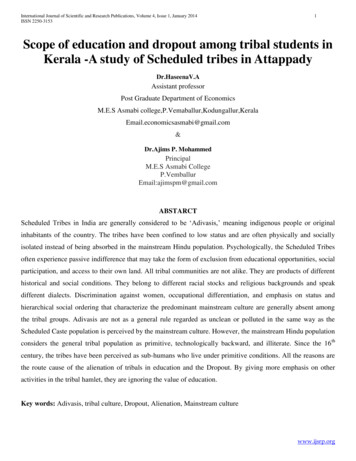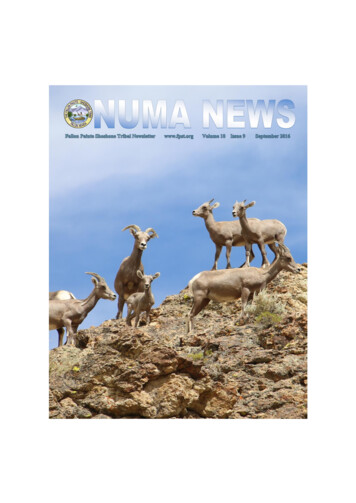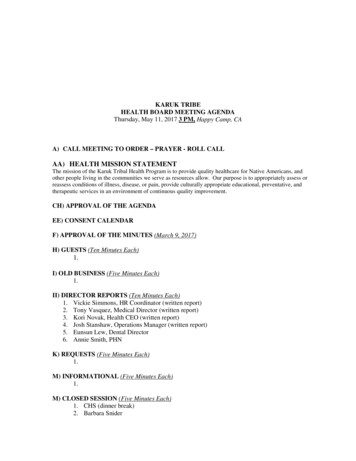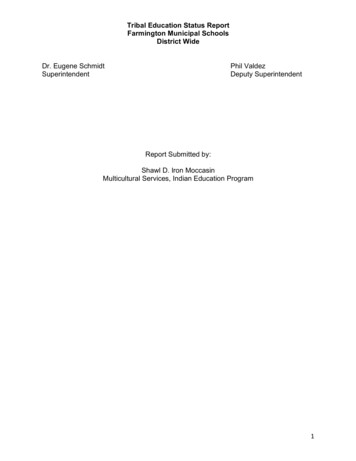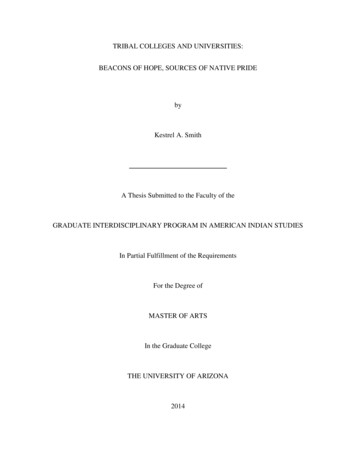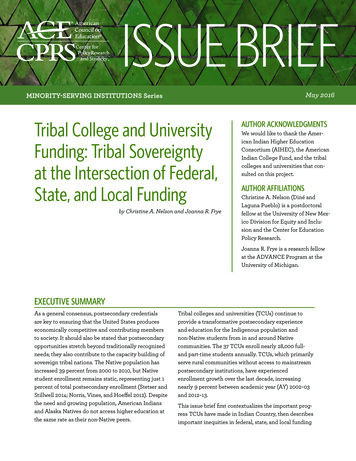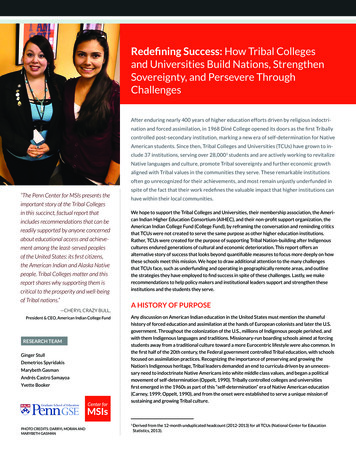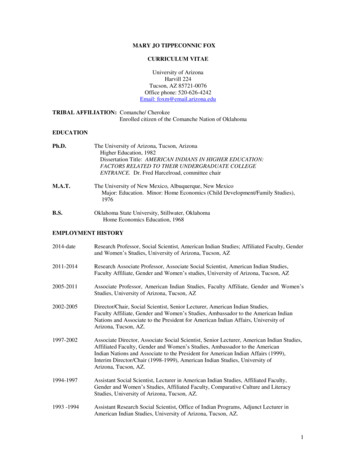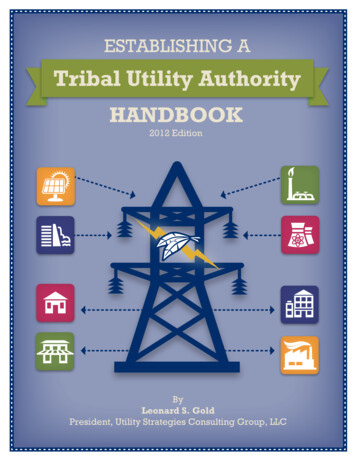
Transcription
ESTABLISHING ATribal Utility AuthorityHANDBOOK2012 EditionByLeonard S. GoldPresident, Utility Strategies Consulting Group, LLC
ESTABLISHING ATribal Utility AuthorityHANDBOOK2012 EditionByLeonard S. GoldPresident, Utility Strategies Consulting Group, LLCPrepared forThe U.S. Department of InteriorIndian Energy and Economic Development (IEED)
Copyright 2012, Leonard S. GoldAll rights reserved. No part of this book may be reproduced in any form without the written permission of the author.10 9 8 7 6 5 4 3 2 1Designed by4645 South Lakeshore Drive, Suite 16Tempe, AZ 85282www.nicecreative.comFirst edition. Printed in the USA
Establishing A Tribal Utility Authority HandbookDisclaimer: This Handbook does not represent the views of the U.S. Department ofthe Interior or any other federal agency. This Handbook is intended to provide anintroduction to electric utility operation and to provide general guidance for thesteps required to form a Tribal Utility Authority.Credit: This Handbook was funded by an economic development grant awarded by theU.S. Department of the Interior’s Office of Indian Energy and Economic Development(IEED) to the Ak-Chin Indian Community and its tribal utility authority, Ak-Chin EnergyServices.iii
Establishing A Tribal Utility Authority HandbookThe AuthorLeonard S. Gold is the owner of Utility StrategiesConsulting Group LLC. He has more than thirty-nineyears of utility and consulting experience. Mr. Gold hasworked with numerous tribes in the Southwest relatingto issues of tribal utility formation and energy issues.Mr. Gold assisted the Ak-Chin Indian Community withthe formation of its tribal utility authority, Ak-ChinEnergy Services (ACES), and currently manages ACES.Mr. Gold also assisted the Gila River Indian Communitywith the formation of its tribal utility authority, the GilaRiver Indian Community Utility Authority. Mr. Gold is also the President of theArizona Tribal Energy Association.iv
Establishing A Tribal Utility Authority HandbookAcknowledgementsMr. Gold wishes to thank the following for their direct support and assistance in thepreparation of this document. Ak-Chin Indian Community Ak-Chin Indian Community Council (Council)- Louis Manuel, Jr., Council Chairman- William J. Antone, Council Vice-Chairman- Delia M. Carlyle, Council Member- Gabriel L. Lopez, Council Member- Terry Enos, Council Member Ak-Chin Energy Services (ACES) Board of Directors- Charles Carlyle, ACES Board Chairman- Brandon Peters, ACES Board Vice-Chairman- Maria Hernandez, ACES Board Member- Adella Zabawa, ACES Board Member- Erno Lopez, ACES Board Member Charles Wiese, General Manger Tohono O’odham Utility Authority William Cyr, General Manager Aha Macav Power Services Amy T. Mignella, Esq. Margaret Schaff, Law Office of Schaff & Clark-Deschene, LLC Mark Randall, Daystar Consulting, LLC Robin Reynolds, Lead Brand and Creative Strategist, NICE Creative, Inc. Terry Rohrs, Senior Graphic Designer, NICE Creative, Inc. Kim Dahle, Administrative Assistant, Utility Strategies Consulting Groupv
Establishing A Tribal Utility Authority HandbookTable of ContentsIntroduction . 11. Electric System Description . 3Generation. 5Transmission Facilities . 6Substations. 6Distribution Facilities. 7Customer Service Facilities. 72. Is A Tribal Utility Authority The Right Choice?. 72.1. Why do you want to from an electric Tribal Utility Authority (TUA)? . 82.2 . What are the tribe’s expectations? . 82.3. How long does it take to form a TUA? . 93. Reasons for TUA Formation . 103.1. Tribal Goals. 103.2. Energy Self-Sufficiency . 103.3. Customer Service . 113.3.1. Establishment of a Local Presence and Jobs . 113.4. Service Reliability . 124. Types of Formation and Formation Documents . 124.1. Types of Formation . 124.2. Formation Documents. 135. TUA Business & Operating Organization . 135.1.5.2.5.3.5.4.5.5.Overview . 13Staffing Requirements . 14Warehouse Requirements . 16Customer Service . 17Operations, Maintenance & Construction (OM&C). 185.5.1. OM&C Equipment Requirements . 195.5.2. Distribution and Maintenance Policies. 195.5.3. Planning, Engineering and Construction Standards . 205.5.4. Training . 205.5.5. Dispatch and Service Restoration . 205.6. Power Purchases . 205.7. Scheduling of Power . 215.8. Scheduling of Transmission . 215.9. Legal . 215.10. Accounting . 215.11. Other as Needed . 22vi
Establishing A Tribal Utility Authority Handbook6. TUA Service . 227. Evaluating the Feasibility of Forming a TUA - Study Steps . 247.1. Overview . 247.1.1. Valuation of Electric Facilities . 277.1.1.1. Conduct field inventory of facilities on reservation . 287.1.1.2. Determine value of inventoried facilities. 287.1.1.3. System Condition . 297.1.2. Pro forma Development . 297.1.2.1. Customer Load and Revenue Forecast. 307.1.2.2. Purchased Power Costs . 327.1.2.3. Transmission and Distribution Delivery Cost . 327.1.2.4. Substations . 347.1.2.5. Distribution Operations, Maintenance and Construction (OM&C) . 347.1.2.6. Distribution OM&C Staffing . 357.1.2.7. Distribution OM&C Material and Stores . 367.1.3. Administrative & General (A&G) Costs . 377.1.4. Revenue Requirement Analysis. 377.1.5. Cash Flow Analysis . 387.1.6. Capitalization Requirements . 387.1.6.1. Capital Equipment . 397.1.7. Distribution & Maintenance Polices . 397.1.7.1. Develop Policies . 397.1.8. Dispatch & Service Restoration . 407.1.8.1. Develop Procedures . 407.1.9. Planning, Engineering & Construction Standards . 407.1.9.1. Develop Construction Standards . 408. Pro forma Example . 419. Mitigation Risk . 439.1. Develop List of Potential Risks . 4310.Summary. 44APPENDIX A . 48vii
Establishing A Tribal Utility Authority HandbookIntroductionThere have been significant advances in technology in the past 15 – 20 years. TheInternet, cellular telephone service and high-definition television have changed the waywe do business and interact with each other on a daily basis. We have become moredependent on these technologies, tending to take for granted that they will always work.However, we also know that this is not always the case – one of several critical drivers forkeeping these technologies working is electricity.Homes, casinos, police departments, fire departments, tribal office buildings, nontribal commercial business on reservations all require electricity for safety, health andfunction.Electricity provides the power to run much household and business equipment.Below is a list of some of the equipment requiring electricity on which our daily activitiesrely. LightsWell and irrigation pumpsCookingHeating and/or coolingRefrigeratorsComputersBattery charges (for cell phones, flash lights, cameras, etc.)StereosTelevisionsAbsent some advance contingency any interruption to the electrical power supplywill likely render much of the above equipment not useable.Before describing an electric utility and the system of facilities it operates, there are afew terms that need to be defined as they will be used throughout this document. Thedefinitions come from the Department of Energy, U. S. Energy InformationAdministration Glossary found at http://205.254.135.7/tools/glossary/index.cfm on theinternet. The following list is not all inclusive and additional definitions can be found onthe website link previously provided. Watt – The unit of electrical power equal to one ampere under a pressureof one volt. (a watt is equal to 1/746 horse power)Kilowatt (kW) – One thousand watts of electricityMegawatt (MW) – One million watts of electricity1
Establishing A Tribal Utility Authority Handbook Watthour (Wh) – The electrical energy unit of measure equal to one wattof power supplied to, or taken from, an electric circuit steadily for onehour Kilowatthour (kWh) - One thousand watthours of electrical energy Megawatthour (MWh) – One million watthours of electrical energy Electric Energy – The ability of an electric current to produce work, heat,light, or other forms of energy. It is measured in watthours and oftenexpressed in kilowatthours (kWh) or megawatthours (MWh) Power – The rate of producing, transferring, or using energy, mostcommonly associated with electricity. Power is measured in watts andoften expressed in kilowatts (kW) or megawatts (MW) Volt – The volt is the International System of Units(SI) measure of electricpotential or electromotive force Kilovolt (kV) – One thousand volts Megavolt (MV) – One million volts Voltage - The difference in electrical potential between any twoconductors or between a conductor and ground Volt-Ampere (Va) –A unit of apparent power, the mathematical productof the volts and amperes in an electrical circuit Kilovolt-Amperes (kVA) - One thousand volt-ampere Megavolt-Amperes (MVA) - One million volt-ampereAn electric utility is a business that provides eclectic power to its customers. The toppriority for an electric utility is safety. Working on or around electric facilities isdangerous. Whether it is a utility person or a customer, caution should always be usedwhen around electric equipment. Safety is ingrained in the electric utility staff daily andinformation is provided to the electric utilities customers to remind them about thedanger of electric facilities.One other important fact about an electric utility is that there could be a significantcost to get into the business. The start-up cost will ultimately be recovered fromcustomers over a period of around 20 years or so. However, initially this will have tocome either through a loan or from tribal funds, but can be repaid through long-termutility payments. The cost to build and operate the electric facilities would be includedin the rates charged for the energy sold to customers.2
Establishing A Tribal Utility Authority HandbookFinally, like any type of complex industry, tribal leaders and staff will need tobecome familiar with the electric utility industry’s distinct terminology. It will take sometime to get up to speed, but it is just a part of the TUA formation process. Further, A TUAmay be subject, directly or indirectly, to the regional utility practices, rules andcontracts. This will need to be considered during the evaluation process for deciding ifforming a TUA is the correct choice.1. Electric System DescriptionIn order to be able to provide electric power to its customers the TUA needs tooperate and maintain s system of facilities that not only produces the electric power, butcan also deliver it to the customer’s location. Electric utilities operate a system offacilities to generate, transmit, and deliver electrical power to the end user, you. Thecost of these facilities can be in the millions of dollars. Figure 1 on the next page is adiagram depicting the different components of an electric system; generation,transmission, distribution and end-user. Also, the reader can go to pages 5-7, whichprovides additional discussion about the electric utility system.3
Figure 1Example of Delivery on (115kv n (69kv 12kv)Substation (69kv CommercialIndustrialCommercial
Establishing A Tribal Utility Authority HandbookIt can be helpful to think about transmission, distribution and customer service as youwould think of a pipeline for transmitting water. Larger pipes are used to bring the waterfrom the source to the location where people live and work. Smaller pipes are used tobring the water down the streets to homes and business. Even smaller pipes are thenused to bring the water into the home or business. The basic components of the electricsystem include, but are not limited to the following: Generation (Nuclear, coal, natural gas, hydro, solar, wind, biogas, steamfrom the earth). Generating plants are rated in kilowatts (kW) ormegawatts (MW). Transmission Facilities (poles and wires that transmit electrical powerover long distances at different voltages) Voltage levels include but arenot limited to 500 kilovolt (kV), 345 kilovolt (kV), 230 kilovolt (kV), 115kilovolt (kV) and 69 kilovolt (kV). Substations (transformers that either step up or step down the voltage).Substation transformers are rated in kilovolt-amperes (kVA) or megavoltamperes (MVA), Distribution Facilities (poles and wires that deliver the power at voltagelevels such as 69 kilovolt(kV), 34 kilovolt(kV), 24 kilovolt(kV)or 12kilovolt(kV) to distribution transformers) Customer Service Facilities ( poles and wires that deliver power to thecustomers meter at voltage levels such as 120 volts, 240 volts, 277 volts,480 volts and meters that measure the power flow.)Generating, transmitting and delivering electrical power requires skilled individualsexperienced in different utility functions. As will be discussed in more detail insubsequent sections, there can be many different levels of involvement in each of theelectric system components. Below is a brief overview of levels of involvement in eachcomponent of the electric utility system. GenerationIn most cases, generators are very large in order to achieve “economies ofscale” or enough return on the capital investment and operating expenses.Generating plants require a substantial investment of capital. Theoperation requires a large and skilled staff. Most small utilities, includingtribal utility authorities (TUA), tend to either obtain a percent ownership ina generating plant or to purchase power from a third party. Percentownership or power purchase allows the TUA to avoid having to hire alarge skilled staff to operate and maintain the generator and can also allowfor a reserve of some amount of capital for other TUA needs.5
Establishing A Tribal Utility Authority Handbook Transmission FacilitiesWith the increased interest in renewable energy, smaller local generatorssuch as solar and small wind turbines can be installed to provide power oran individual or small group of individuals. These types of technologiesalso require skilled staff to operate and maintain. The cost of installation istypically above that of the cost of generation from a large conventionaltype generator.Transmission is built to bring power from generating stations over longdistances to local areas where the power is to be consumed. Transmissionlines typically connect generators to substations. The development andconstru
An electric utility is a business that provides eclectic power to its customers. The top priority for an electric utility is safety. Working on or around electric facilities is dangerous. Whether it is a utility person or a customer, caution should always be used when around electric equipment.File Size: 2MB



